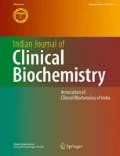Abstract
R-plasmids that transfer antibiotic resistance are common in the non-pathogenicEscherichia coli of the gastro-intestinal tract of human beings and domestic animals, which inturn may enter into sewage. Therefore we have isolated 30Escherichia coli isolates from hospital sewage of Aligarh city. These isolates were tested for their resistance and sensitivity against 10 antibiotics. 90% isolates showed resistance against ampicillin and sulphamethizole. Of the total 30E. coli isolates 86.6% were resistant to erythromycin and rifampicin but none of them was resistant to kanamycin and streptomycin. Plasmids (mol. wt. 16.5 mega daltons) were isolated from five differentE. coli strains which harboured only a single plasmid and were characterized on the basis of antibiogram. Moreover, the transformation experiments were also performed to confirm the resistant character on the plasmid. We conclude that multiple drug resistance among most of theE. coli isolates is plasmid borne.
Similar content being viewed by others
References
Murray, B.E. (1991) New aspects of antimicrobial resistance and the resulting therapeutic dilemmas. J. Infect. Dis. 163, 1185–1194.
Neu, H.C. (1992) The crisis in antibiotic resistance. Science 257, 1064–1073.
Shanahan, P.M., Thomson, C.J. and Amyes, S.G. (1994) Beta-lactum resistance in aerobic faecal flora from general practice patients in the UK. Eur. J. Clin. Microbiol. Infect. Dis. 13, 760–763.
Woodford, N. (1998) Glycopeptide-resistant enterococci: a decade of experience. J. Med. Microbiol. 47, 849–862.
Arnold, E. and Greenberg, R. Standard method for the examination of water and waste water. Marry AHF (editor)American Public Health Association. 16th ed. Washington DC: Port City Press, Baltimore, Maryland; 1985, p. 872–917.
Coleman, D.C., Pomeroy, H., Estridge, J.K., Keane, C.T., Cafferkey, M.T., Hone, R. and Foster, T.J. (1985) Susceptibility to antimicrobial agents and analysis of plasmids in gentamycin and methicillin-resistantStaphylococcus aureus from Dublin hospitals. Journal of Medical Microbiology 20, 157–167.
Kado, C.I. and Liu, S.T. (1981) Rapid procedure for detection and isolation of larger and small plasmids. Journal of Bacteriology 145, 1365–1373.
Lederberg, E.M. and Cohen, S.N. (1974) Transformation ofSalmonella typhimurium by plasmid deoxyribonuclic acid. Journal of Bacteriology 119, 1072–1074.
Austin, D.J., Kakehashi, M. and Anderson, R.M. (1997) The transmission dynamics of antibiotic resistant bacteria: the relationship between resistance in commensal organism and antibiotic consumption. Proc. R. Soc. Lond. B. Biol. Sci. (UK) 264, 1629–1638.
French, G.L., Ling, J., Chaw, K.L. and Mark, K.K. (1987) Occurance of multiple antibiotic resistance and R-plasmid in gram negative bacteria isolated from faecally contaminated fresh water streams in Hong Kong. Epidemiology Infection 98, 285–299.
Khan, A.U., Ajamaluddin, M., Khan, M.A. and Naeem, A. (1999) Analysis of multiple drug resistance in theEscherichia coli of sewage and drinking water collected from domestic area of Aligarh city. Journal of Microbial World 1, 29–32.
Katayama, J., Okada, H., O’Hara, K. and Noguchi N. (1998) Isolation and characterization of two plasmids that mediate macrolide resistance inEscherichia coli: transferability and molecular properties. Biological Pharmaceutical Bulletin (Japan) 21, 326–329.
Actis, L.A., Tolmasky, M.F. and Cross, J.H. (1999) Bacterial plasmids: replication of extrachromosomal genetic elements encoding resistance to antimicrobial compound. Frontiers in Biosciences 3, 43–62.
Reed, C.S., Barrett, S.P., Threfall, E.J. and Cheasty, T. (1995) Control of infection with multiple antibiotic resistant bacteria in a hospital renal unit: the value of plasmid characterization. Epidemiology Infection 115, 61–70.
Malkawi, H.I. and Youssef, M.T. (1998) Antibiotic susceptibility testing and plasmid profiles ofEscherichia coli isolated from diarrhoeal patients. Journal of Tropical Paediatrics 44, 128–132.
Chaslus-Dancle, E., Gerbaud, G., Lagorce, M., Lafont, J. and Courvalin, P. (1987) Persistance of an antibiotic resistance plasmid in intestinal Escherichia coli of chickens in the absence of selection pressure. Antimicrobial Agents and Chemotherapy 31, 784–788.
Bopp, H.C., Chakarbatry, A.M. and Ehrlich, H.L. (1983) Chromate resistance plasmid in Pseudomonas fluorescence. Journal of Bacteriology 155, 1105–1109.
Author information
Authors and Affiliations
Corresponding author
Rights and permissions
About this article
Cite this article
Ajamaluddin, M., Khan, M.A. & Khan, A.U. Prevalence of multiple antibiotic resistance and R-plasmid inEscherichia coli isolates of hospital sewage of Aligarh city in India. Indian J Clin Biochem 15, 104–109 (2000). https://doi.org/10.1007/BF02883736
Issue Date:
DOI: https://doi.org/10.1007/BF02883736




